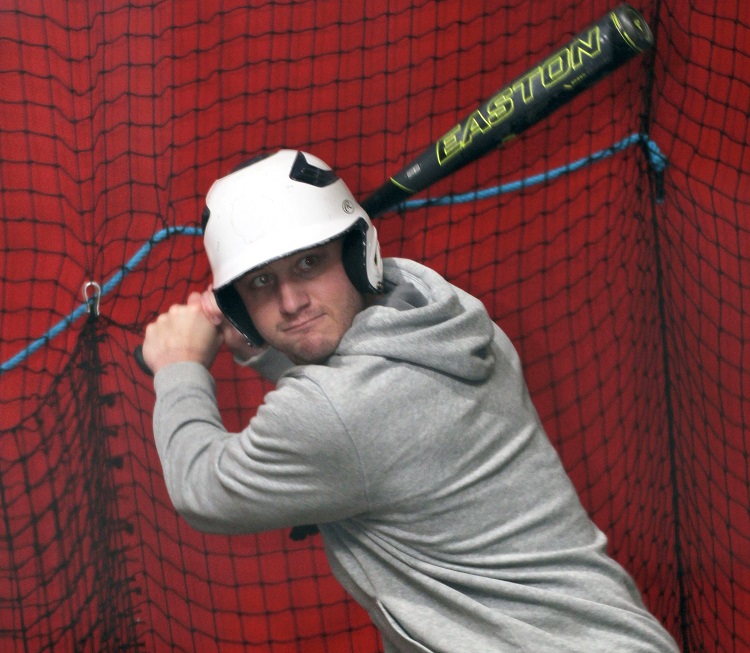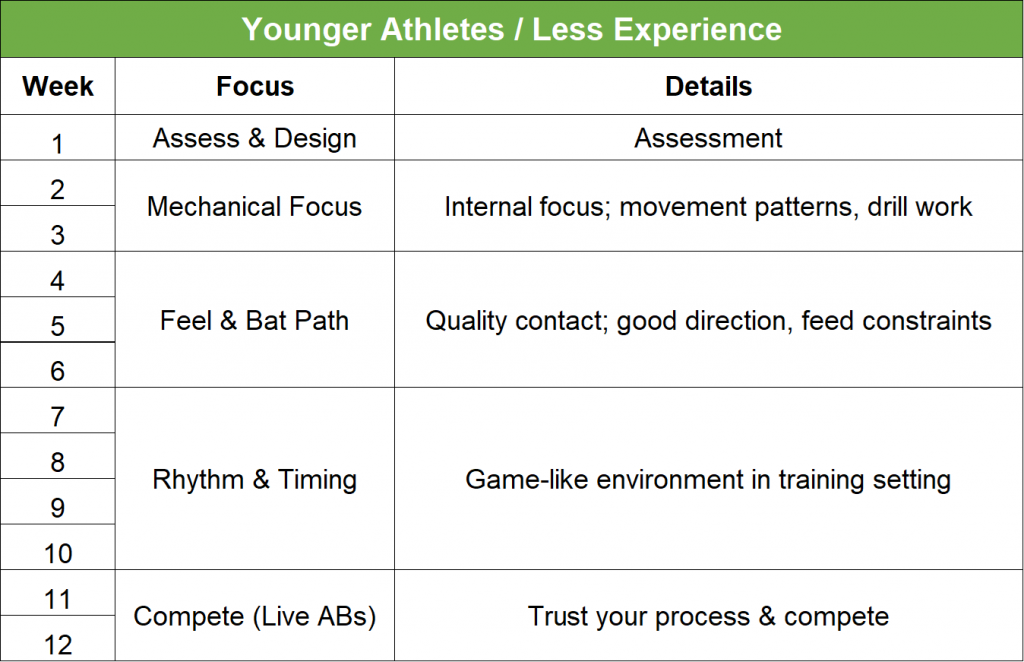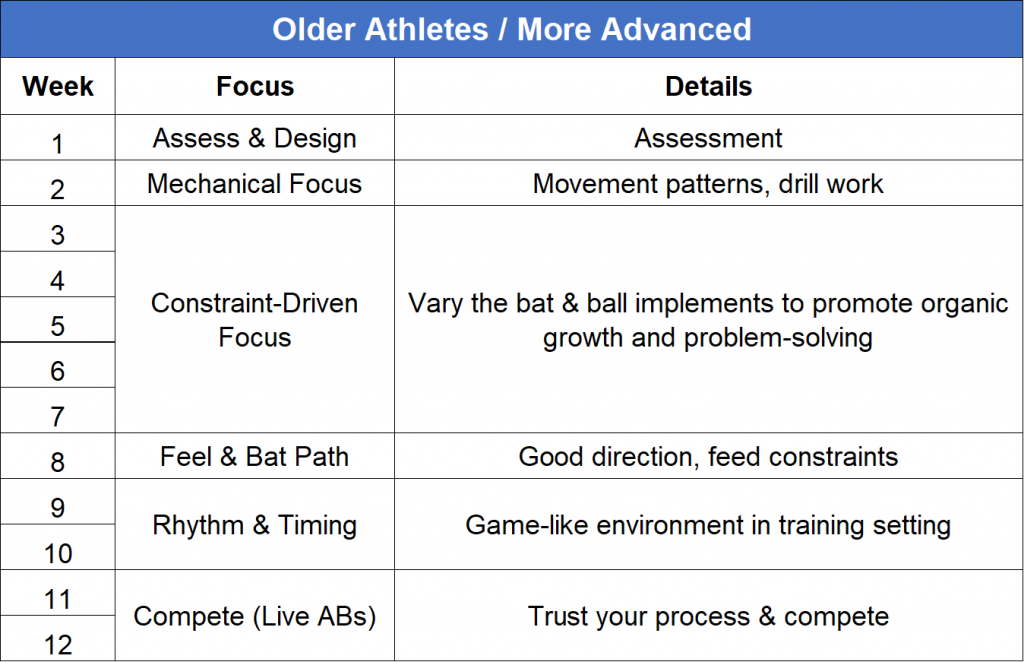
The following is a list of “frequently asked questions” that we often receive on our off-season hitting program. Hope it’s helpful, but please feel free to reach the front desk at 201-308-3363 with any additional inquiries at any time or set up a visit where we can give you an on-site tour and review the programming.
Hitting Program Q&A
Q: Will my bat speed and exit velo improve?
Improving bat speed and exit velo is one of the program priorities. Obviously one measure is a pre-contact metric, while the other is post-contact. There are several topics that go into improving bat speed and exit velo, including:
-
- Strength and power
- Mobility
- Kinematics sequence
- Hitting mechanics
The first two of these topics are addressed in the weight room, while the last two are generally addressed inside the nets. The overall plan is to get you strong and mobile, and combine that with improved sequencing and hitting mechanics to help improve your bat speed and exit velo. We have seen great results in the past and expect to continue to see more in the future.
Q: Can you review what’s involved in your hitting assessment?
The program begins with a hitting assessment of pre-contact and post-contact metrics, including the following:
-
- K-vest Kinematic Sequence (pre-contact) – K-vest is a 3D motion capture sensor technology for baseball players. It primarily measures how the athlete is creating velocity up the kinetic chain and more specifically the kinematic sequence with which he does it.
- Blast Motion Swing Profile (pre-contact) – If you don’t own a Blast Motion baseball sensor, you should. They are relatively inexpensive. They provide a number of metrics about your swing profile that can be very instrumental in evaluating your success at the plate.
- HitTrax Batted Ball Evaluation (post-contact) – HitTrax provides a plethora of data in a variety of formats on batted balls that helps us evaluate a hitter’s performance at the plate, including spray charts, depth of contact and strike zone information.
- Hitting Mechanics Video Analysis – We perform a thorough video analysis on every player in our program. It’s a step by step review of the athlete’s mechanics best summarized in two buckets, the Stride Phase and the Swing Phase.
-
Q: Can you review what you will be doing inside the nets during the course of the program? Do you have a timeline?
When the hitting portion of the winter program begins we have prepared a plan for every player. Each athlete is prescribed specific hitting drills which they will perform prior to each hitting session. For the duration of the program (except for the Holidays), we hit 2x per week. The following is a general weekly outline of the program (approximately 3 months):
-
- Assess and Design
- Mechanical Focus
- Constraint Driven Focus (more advanced players)
- Feel and Bat Path
- Rhythm and Timing
- Compete (Live At Bats)
We also alter the progression depending on the levels of players in each group as follows:


Q. Is strength training only about hitting for power?
Absolutely not! Hitting is a complex task and to be successful at the plate you need strength and mobility that can help create, not only power and explosiveness, but also adjustability.
In what only normally takes approximately 130 ms (the baseball swing), a lot can go right and wrong. Strength helps in every way. It not only helps reduce the risk of injury, there are many correlations between strength and mobility and their assistance with potential improvements in your mechanics.
Upper Body Strength:
-
- Starting strength in the first move
- Bat speed
- Torso acceleration / deceleration
Shoulder Strength / Mobility:
-
- Scap load
- Creating space with the hands
- Staying on plane
Core Strength:
-
- Stabilizing center of mass or COM (maintaining posture, rotational acceleration staying on plane)
- Creating / resisting rotation (hip / shoulder separation)
- Transfer of power from lower half to upper half (k- sequence)
Lower Body Strength / Mobility / Stability:
-
- Back / front leg stability
- Hip hinge
- Glute load
Q: Do you perform video analysis on the players?
As we mentioned above, we perform a video analysis on every player that enters our programs. Here is a brief outline of how we break down hitting mechanics in 15 steps during video review, from the Stride Phase which begins at set-up and ends at heel plant, to the Swing Phase which begins as the front leg blocks at heel plant and the body begins to accelerate its rotation against a firm front side, ultimately ending at contact.
Stride Phase
-
- Stride Phase: Setup / Stance
- Stride Phase: Excessive Negative Weight Shift
- Stride Phase: Poor Rear Hip Load
- Stride Phase: Inability to Maintain COM
- Stride Phase: Lack of Linear Momentum
- Stride Phase: Lack of Independent Hands
- Stride Phase: High Elbow
- Stride Phase: Losing the Barrel
- Stride Phase: Stride Length
- Stride Phase: Lack of Lower Half Stability
Swing Phase
-
- Swing Phase: Front Knee Angle
- Swing Phase: Inefficient Lead Leg Block
- Swing Phase: Poor Axis of Rotation
- Swing Phase: One-Piece Swing
- Swing Phase: Push
Every player, to varying degrees, has disconnects which we look to address in the weight room and inside the nets through specific drills.
Q: How many strength training and hitting sessions are there in the program?
On the hitting side, there are approximately 2 dozen sessions (2x per week) during the program (actual count may vary slightly each year due to the calendar).
On the strength side, it depends on whether you’re training in the 13-16 year old or 16 and older group.
-
- The younger age group meets 2x per week at specific times and, excluding vacations, includes over 2 dozen strength training sessions from mid-November through early March (once again calendar may vary the actual count).
- The older age athletes that are approved to train in more advanced programs can train up to 5x per week for the duration of the program.
Q: What is the athlete to hitting coach ratio?
The off-season hitting program is done in groups of up to 3 athletes, generally grouped by age / grade / ability.
General Questions
Q: What is the difference between your “13- to 16-year-old” and “16 and older” programs?
The difference between the younger and older group is primarily about the weight room and our lifting program.
If you are 13-16 years old and have never trained at RPP before, you should enroll in the younger group which trains twice per week with a strength coach. On the other hand, if you are 16 or older (and have prior RPP training experience) you can seek approval to train in the older group where you can train 4-5x per week. There are several criteria that go into our approval process, including:
-
- 16 years old at time of approval
- Physically mature (examples… 5’9” /170 lbs. or 6’0” / 180 lbs. and NOT 5’10” / 125 lbs.)
- Demonstrate the ability to conduct yourself properly around the weight room
- Be able to train more independently with less direct supervision
Our decision on this topic is solely based on overall safety in the weight room and our belief that the athlete has the ability and desire to train more independently with a more rigorous and demanding weightlifting program. Most 16-year-olds that are new to RPP can get qualified for the older group once they get more experience in the weight room. 17-year-olds are automatically enrolled in the older group.
Q: Is the strength training in group setting or individual?
As mentioned earlier the younger group train twice per week in groups of up to six per coach. The strength training is baseball-specific and intended for rotational athletes such as pitchers and position players.
The older group of athletes receive more advanced and individualized training programs, and they are expected to be more experienced in the weight room. They have their own customized program which is based on the upfront assessment. They train more independently. However, our coaches are always available to them on the floor to answer questions.
Q: Why do your programs start in November?
Our off-season strength programs start earlier than most others because much of what we look to attain revolves around getting our athletes stronger and more mobile. Our programs begin in November so that we can begin our work in the weight room. Once we have begun to address the physical needs of our athletes, in December we begin working on the skill side of the equation, whether it be pitching or hitting.
Q: What do you suggest for 2-way players?
We always suggest that 2-way players train as pitchers at RPP, and then hit on days when they are not pitching or throwing. Our pitcher programming provides for more arm care which players could use as well given the volume of games they play during the year.
Q: Can parents watch the sessions?
Yes, parents can join us this year. But first, please check with front desk so that we can manage the process. If you do attend, please stay outside the weight room areas, and please do not engage with the instructors during the sessions. We would be happy to set up a time to review your young athlete’s strengths, weaknesses, and development.
Q: Can we go over the results of the upfront evaluation?
Yes. We are currently planning for reviews in November to go over the results with those who want to review them.
Additional Questions?
Hopefully, we have answered your questions. Please feel free to reach the front desk at 201-308-3363 with any additional inquiries at any time or set up a visit / “consult session” where we can give you an on-site tour and review the programming.
If you’d like to be placed on our email list please enter your email address below!
